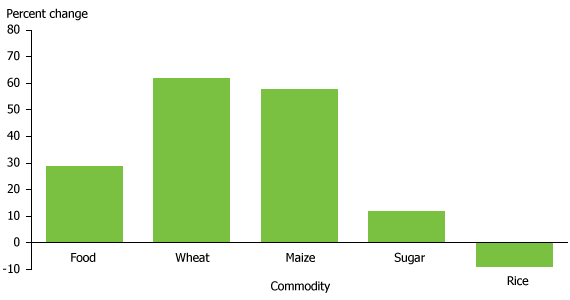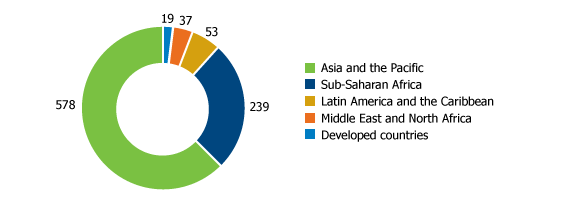Kata Fustos
Former Intern

April 8, 2011
Former Intern
(April 2011) Global food prices have been rising, threatening to reach record levels in the coming months if current trends continue. Growing world demand due to increasing world population and shifting consumption patterns, and lower supplies partly due to bad weather raised the World Bank’s food price index by 15 percent between October 2010 and January 2011.1 The index increased by 29 percent overall between February 2010 and February 2011. In January, the Food Price Index of the United Nations Food and Agriculture Organization (FAO) was at its highest level since tracking began in 1990.2 While not all countries are affected equally, the recent volatility is particularly alarming in regions where people spend more than half of their income on food.
A combination of unfavorable weather patterns around the world and uncertainty in the quality of wheat harvests in China has affected the global food supply. Record heat and drought in 2010 in the former Soviet Union sharply reduced wheat production and dealt a shock to global wheat supplies. Extreme dry weather in Brazil—a major food exporter—contributed greatly to worldwide deficits of sugar, soybeans, and maize. Devastating rain and floods in Australia damaged wheat crops and reduced the yields of sugar harvests. Additionally, a severe drought in China threatens the harvest of the country’s wheat crop and has prompted the FAO to issue a special alert, characterizing the current situation as “potentially a serious problem.”3 For decades, China has relied mostly on its own domestic grain production and was absent from the global grain market. However, if the drought destroys a significant portion of the harvest and China has to import grain to fulfill domestic demand, the impact can shock the world market and cause even sharper increases in global prices. As a result of China’s buying power, it can outbid others in the global market, and secure supplies for its own population. An expanding world population, greater reliance on crops as biofuels, and shifting diets continue to increase the collective demand for food, making the gap between supply and demand even wider. Since price volatility and growing demand are likely to persist, “we need global action to ensure we do a better job of feeding the hungry before we face the future challenges of feeding the expected 9 billion people in the world in 2050,” said Robert Zoellick, World Bank president.4
According to the World Bank index, global sugar prices reached a 30-year high in the beginning of 2011, after increasing 12 percent since January 2010. Edible oil prices have risen 73 percent since June 2010. Among grains, the price of wheat has increased the most, more than doubling between June 2010 and January 2011. The price of maize has been affected by the surge in the wheat and oil markets and also jumped about 73 percent during the second half of 2010. Other food items that contribute to dietary diversity, such as vegetables and beans, have also experienced large price increases. Prices do not rise at the same rate in all countries; domestic markets are affected based on how well governments are able to shield their population from global price surges through the use of subsidies, import taxes, and increased domestic production.
 Source: World Bank, “Commodity Price Data (Pink Sheet),” accessed at http://siteresources.worldbank.org/INTDAILYPROSPECTS/Resources/Pnk_0411.pdf, on April 1, 2011.
Source: World Bank, “Commodity Price Data (Pink Sheet),” accessed at http://siteresources.worldbank.org/INTDAILYPROSPECTS/Resources/Pnk_0411.pdf, on April 1, 2011.
Although food prices had been increasing for seven consecutive months by February 2011, the price of all items had not grown at the same pace (see Figure 1). According to the World Bank’s Food Price Watch, this differentiates the current situation from the price surges of 2008, when food riots broke out across the developing world. Meat prices have stayed relatively stable over the past year. Following good harvests in exporting countries, the global price of rice was actually lower at the end of 2010 than in the beginning of the year, and it remains 70 percent below its 2008 peak. Therefore, rice provides a more affordable alternative grain to the poor and its accessibility has prevented more people from sinking into poverty and undernourishment. At the same time, some Asian economies have seen sharp increases in rice prices. In Vietnam, Bangladesh, and Indonesia—all high rice consumption countries—domestic rice prices increased over 30 percent in the past year.5
Soaring food prices disproportionately hurt the poor in developing countries. This is especially true in regions where people spend a majority of their income on food and rely on a specific food product. Although some farmers and food producers are benefitting from greater profits, the net effect of higher prices is a rise in the number of the poor. The World Bank estimates that an additional 44 million people have fallen into poverty in the developing world as a result of higher food prices. Overall, the number of chronically hungry people began to climb again after a brief decrease to 925 million in 2010 (see Figure 2). According to Zoellick, “the trends towards the 1 billion are worrisome. Global food prices are rising to dangerous levels and threaten tens of millions of poor people around the world.”6

Source: FAO Statistics Division, accessed at www.fao.org/economic/ess/en/, on April 7, 2011.
Food prices are rising faster in India than in other large economies. As the country’s population continues to grow and middle class incomes rise, there is increasing pressure on the government to provide food for the entire country. Despite rapid economic growth over the past decade, India still struggles to feed its population: According to the 2005/2006 National Family Health Survey, 40 percent of children below the age of 3 were underweight and 45 percent were stunted.7 Lack of investment has kept domestic agricultural productivity low as manual labor remains the dominant source of domestic food production. In 2008/2009, agriculture employed about 52 percent of the labor force, but only made up 13 percent of India’s GDP.8 Farming and agriculture remain greatly inefficient and inadequate for feeding the country’s 1.2 billion people. Low production and an unusually wet summer in 2010 contributed to the current domestic food inflation that reached a 16 percent annual rate in January 2011. This composite figure masks the rise in the price of some staples, such as onion and garlic, which rose by 71 percent during the past year. The sharp increase is most alarming for the 41 percent of the population in India who live on $1.25 or less a day and spend a majority of their income on food, as even basic items are becoming unaffordable.9 The government is responding to the current crisis by providing heavy subsidies for agricultural production and by importing increasing amounts of some staples, such as lentils and beans, to ensure their availability. It has also put export restrictions on certain products to keep them for domestic consumption.10 These policies can only provide temporary solutions, however: Long-term investment is required in agricultural research to improve the quality of seeds, irrigation techniques, and modernize other production components.11
Kata Fustos is a Communications intern at the Population Reference Bureau.
